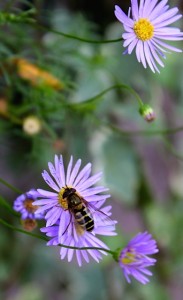29
Jun
Neonicotinoids Hinder Bee’s Ability to Smell Flowers
(Beyond Pesticides, June 29, 2015) A recent study has provided supporting evidence to previous work showing that sublethal doses of imidicloprid, a toxic neonicotinoid insecticide, impairs olfactory learning in exposed honey bee workers. Since 2006, honey bees and other pollinators in the U.S. and throughout the world have experienced ongoing and rapid population declines. The science has become increasingly clear that pesticides (especially the neonicotinoid class of insecticides), either acting individually or synergistically, play a critical role in the ongoing decline of honey bees and wild pollinators. Neonicotinoids can be persistent in the environment, and have the ability to translocate into the pollen and nectar of treated plants.
 “Honeybees need to learn to associate nectar reward with floral odor. One of the main reasons why flowers produce odor is so that this odor can be learned by pollinators and used to repeatedly visit the same flower species. Without this repeat visitation, pollination does not occur. We showed that a neonicotinoid pesticide, at sublethal doses, harms this odor memory formation,” Chinese Academy of Science’s Ken Tan, who led the study, told CBS News in an email interview.
“Honeybees need to learn to associate nectar reward with floral odor. One of the main reasons why flowers produce odor is so that this odor can be learned by pollinators and used to repeatedly visit the same flower species. Without this repeat visitation, pollination does not occur. We showed that a neonicotinoid pesticide, at sublethal doses, harms this odor memory formation,” Chinese Academy of Science’s Ken Tan, who led the study, told CBS News in an email interview.
Published in Nature on June 18, 2015, the study finds that “adults that ingested a single imidacloprid dose as low as 0.1”‰ng/bee had significantly reduced olfactory learning acquisition, which was 1.6-fold higher in control bees. Bees exposed as larvae to a total dose of 0.24”‰ng/bee had significantly impaired olfactory learning when tested as adults; control bees exhibited up to 4.8-fold better short-term learning acquisition.” Researchers conclude that this sublethal cognitive deficit caused by low dose exposure to neonicotinoids on a broad range of bee species is cause for further study.
A January 2015 study that also looked at sublethal exposure to imidacloprid found that it leads to mitochondrial dysfunction in bumble bees, which then negatively impacts navigation and foraging skills. For example, exposed bees will have greater difficulty in recognizing the smell of a flower, or how to find their way back to their colony, which in turn can affect the colony as a whole. Two other recent studies found that, not only does neonicotinoid exposure result in reduced bee density, nesting, colony growth, and reproduction, but also that bees actually prefer foods containing neonicotinoid pesticides, despite their adverse effects. Put simply, this means that bees can become addicted to neonicotinoid-contaminated flowers in the same way that humans can become addicted to cigarettes.
These studies add merit to the growing body of work that implicates neonicotinoid pesticides as the cause of bee declines. It has already been indicated that exposure to neonicotinoids can leave honey bees and other important non-target species vulnerable to viruses and predators, such as the Varroa mite. The pesticide industry often asserts that these viruses and predators are the only factors causing bee declines, but the refuting point that can be extracted from the studies above is that low-dose exposure to neonicotinoid pesticides is the tipping point, the first domino in a long line of implicated causes. Neonicotinoids, such as imidacloprid, break down normal functioning of these insects, which then leaves them dangerously vulnerable to viruses, predators, and other negative impacts.
The Environmental Protection Agency (EPA) has consistently fallen short in its efforts to mitigate these harmful effects to bees and other pollinators. In May 2015, EPA released a proposal intended to create “physical and temporal space” between bees and toxic pesticides. They call these spaces “pesticide-free zones,” which has been called misleading by environmentalists. While touted as monumental progress on bee health by the agency, the reality is that the proposed minor label change won’t stop the widespread contamination of landscapes or prevent harm associated with systemic neonicotinoids. Pollinators and other non-target organisms face unique threats from these systemic pesticides because they can be exposed through multiple pathways, including directly through foliar applications and contaminated field dust from seed treatments, as well as indirectly through contaminated guttation droplets, pollen, and nectar of treated plants.
In light of the shortcomings of federal action to protect these beneficial creatures, it is left up to us to ensure that we provide safe havens for pollinators by creating pesticide-free habitat and educating others to do the same. Take action by calling on EPA to suspend neonics now. You can also declare your garden, yard, park or other space as pesticide-free and pollinator friendly. It does not matter how large or small your pledge is, as long as you contribute to the creation of safe pollinator habitat. Sign the pledge today. Need ideas on creating the perfect pollinator habitat? The Bee Protective Habitat Guide can tell you which native plants are right for your region. For more information on what you can do, visit our BEE Protective page.
All unattributed positions and opinions in this piece are those of Beyond Pesticides.










